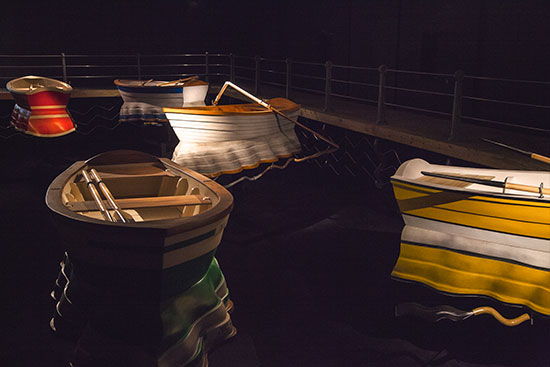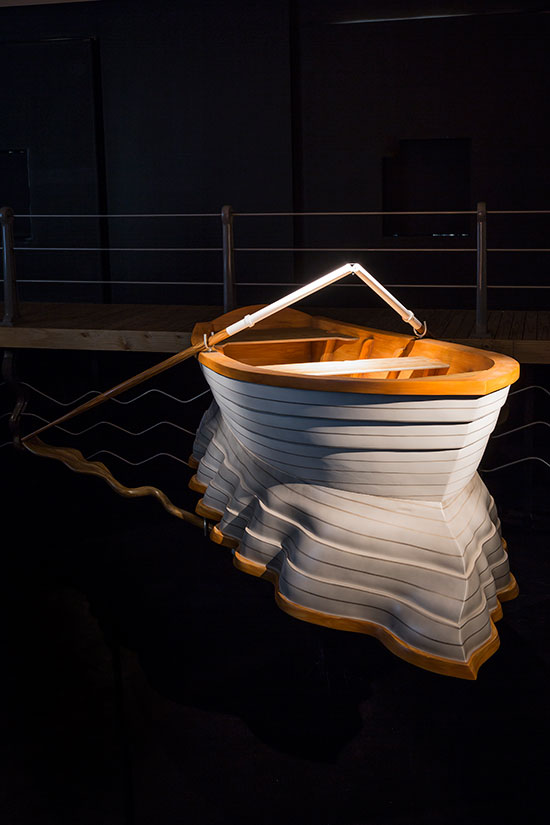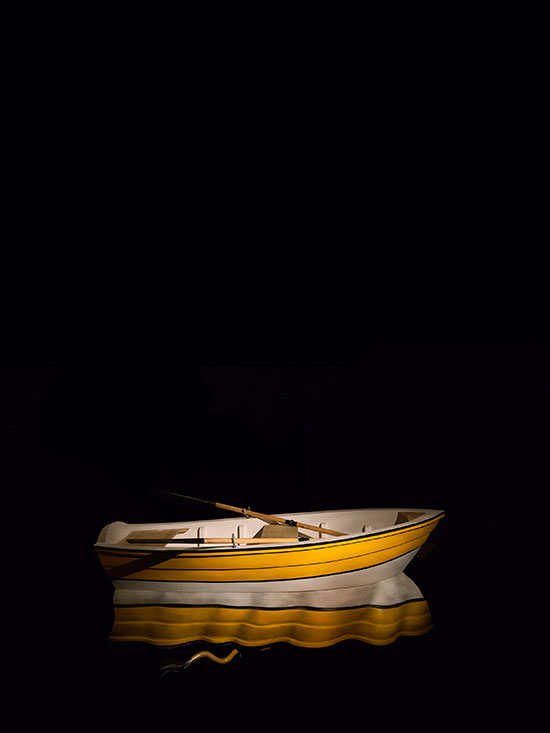PURCHASE, N.Y. — Five rowboats float silently in a nighttime harbor. Rocking gently, their hues catch the light: one scarlet, another yellow, another gleaming white. The boats are empty, their oars at the ready, their reflections shimmering beneath them.
But wait. Those are not reflections. They are as physical as the rowboats they are under—constructed from the same materials, rippling mirror images, oars included. And the boats are not floating, because there is no water. This is the Theater Gallery at the Neuberger Museum of Art, in Purchase, N.Y., and the colorful boats, the railed boardwalk that surrounds them and the deceptively undulating reflections of the entire scene comprise Leandro Erlich’s nearly 2,700-square foot, life-size installation, “Port of Reflections.”
.

"Puerto de Memorias (Port of Memories)" by Leandro Erlich, 2016. Mixed media installation. Dimensions variable. MUNTREF Museum de la Universidad Nacional de Tres de Febraro, Buenos Aires © MUNTREF. Photo: Alvaro Figueroa.
.
In the gallery at the Westchester County art museum, visitors may experience an unlikely combination of responses. The darkened environment and the hushed swaying of the rowboats are mesmerizing, meditative. But the mysteries of the construct might spark curiosity and an urge to figure it all out.
This push and pull—between passive contemplation and active deciphering, between the familiar and the fantastic, between what is real and what is illusion—pervades Erlich’s oeuvre. An Argentinian conceptual artist whose work has been shown internationally, Erlich, 43, is the fourth recipient of the Roy R. Neuberger Exhibition Prize, given to an exceptional artist for an early-career survey and monographic catalogue.
The survey at the Neuberger is titled “Port of Reflections,” co-curated by Patrice Giasson, the museum’s Alex Gordon Associate Curator of Art of the Americas, and Helaine Posner, Chief Curator. It comes on the heels of another exhibition featuring Latin American artists, “Destination: Latin America,” a group show that closed in January. “Port of Reflections,” with the eponymous installation as the centerpiece, also presents large-scale photographs, models and videos documenting other projects by Erlich spanning more than a decade.
.

"Puerto de Memorias (Port of Memories)" by Leandro Erlich, 2016. Mixed media installation. Dimensions variable.. MUNTREF Museum de la Universidad Nacional de Tres de Febraro, Buenos Aires © MUNTREF. Photo: Diego Spivacow.
.
New Yorkers might have seen Erlich’s Swimming Pool at MoMA PS1, where it was on display from 2008 to 2010. Represented at the Neuberger in a photograph, the life-size pool confounded viewers who watched fully clothed people walking around underwater. The “pool” was, in fact, a water-free space beneath a sheet of acrylic covered by a few inches of water, producing a convincing illusion for both those peering into it and those peering up. Originally constructed in 1999, Swimming Pool was part of the Argentinian Pavilion at the 49th Venice Biennale in 2001; a version is in the permanent collection of the 21st Century Museum of Contemporary Art in Kanazawa, Japan.
Swimming Pool is one example of how Erlich’s work encourages spectators to become participants. Another is his series of trompe l’oeil buildings, first shown as Bâtiment (“Building”) in 2004. The exhibition includes photographs of the 2011 Bâtiment II and Bâtiment III and a nearly six-foot-tall cast resin model and video of Dalston House, installed at Dalston Mill in East London in 2013.
Each iteration is an optical illusion: a life-size building façade lying horizontally and reflected in a giant mirror that makes it look like an upright neighborhood edifice. The piece is activated when viewers occupy the façade’s surface, posing playfully, appearing to dangle from a window or hang precariously from a ledge.
On a recent afternoon, Erlich joined a group of Neuberger visitors and spoke of the power of this kind of interaction. “What we are seeing,” he said, “is people who are taking the installation and, in an act of appropriation, making the artwork something else.”
He credited the transformation to the creativity of those appropriators. “I think that artists are not the only ones playing with creativity,” he said. “The action of interpretation is a creative action.”
In 2015, Erlich extended the reach of such creative response beyond the museum to the general public. His Obelisco sin Punta desde Diagonal Norte —La Democracia del Símbolo (“Obelisk without Apex from Diagonal North Street—The Democracy of the Symbol”) was a temporary intervention in Buenos Aires in which a huge cubic box was placed over the pyramidal apex of the city’s Obelisco, seemingly decapitating the 220-foot-tall monument. Concurrently, a full-scale replica of the apex, titled La Punta/Obelisco sin Punta – La Democracia del Símbolo (“The Apex/ Obelisk without Apex – The Democracy of the Symbol”), was placed at the Latin American Art Museum of Buenos Aires (MALBA). Visitors could enter the pyramid and watch digital projections of the views they might have seen from atop the monument.
Standing beside photographs of both pieces at the Neuberger, Erlich explained that the city’s Obelisco was not constructed to be accessible, so witnessing the vistas from its top was a tantalizing impossibility. “It is part of every Argentinian’s imagination: what would be the view from up there?” he said.
Pondering these and other works provides intellectual context for the sensory experience of entering the Port of Reflections installation. The space is serene, otherworldly, with reflections not just visual but also pensive, perhaps emotional. Erlich mentioned his desire to preserve a fleeting moment—“something as ephemeral as a reflection on water,” he said—that is frozen in its materiality in his piece. There is, it should be noted, one reflection that cannot be found: the visitor’s own face in water that does not exist.
.

"Puerto de Memorias (Port of Memories)" by Leandro Erlich, 2016. Mixed media installation. Dimensions variable. MUNTREF Museum de la Universidad Nacional de Tres de Febraro, Buenos Aires © MUNTREF. Photo: Alvaro Figueroa.
.
At the museum, Erlich noted the symbolism inherent in boats. They are sources of leisure and commerce, departure and arrival, escape to all sorts of destinations. They conjure change and movement that is sometimes hopeful, sometimes angst-ridden. As he said, “Boats in history were taken as a metaphor for the transit in life.”
Then he hesitated, interrupting the group’s rapt attention. “But now,” he said, “I think that whatever I have to say, it will not be more important than what you have to think.”
.

"Puerto de Memorias (Port of Memories)" by Leandro Erlich, 2016. Mixed media installation. Dimensions variable. MUNTREF Museum de la Universidad Nacional de Tres de Febraro, Buenos Aires © MUNTREF. Photo: Alvaro Figueroa.
.
____________________________________
BASIC FACTS: “Leandro Erlich: Port of Reflections” runs through July 30, 2017 at the Neuberger Museum of Art, 735 Anderson Hill Road, Purchase, NY 10577.
On March 29, 2017 at 6:30 p.m., a panel discussion on “The Uncanny Work of Leandro Erlich” will feature Andrea Giunta, Professor of Latin American Art at the Universidad de Buenos Aires, along with curators Helaine Posner and Patrice Giasson. The artist takes part during the final 30 minutes via Skype. For more information: www.neuberger.org
____________________________________
Copyright 2017 Hamptons Art Hub LLC. All rights reserved.
